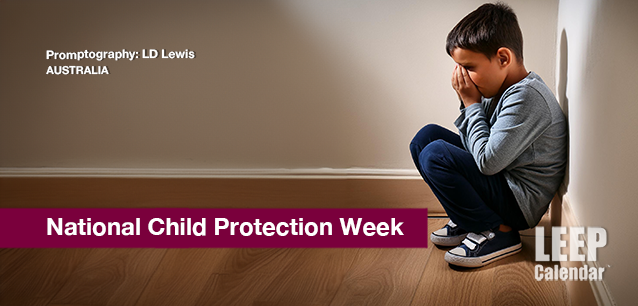 AD
AD
Today is: December 06
Scroll to explore events active on this date.
LEEP INK FEATURES

August? Absolutely!
In August, we live through the Dog Days of Summer. It's hot and often humid, and those who can leave for better climates do. Down south, winter is in full force. August is also known as "the ...

In The Heat of July: July 2025 Events
Is it hot enough (or cold enough if you're below the equator) for you yet? There is actually a day for that! Like every month, I pick a diverse collection of events you may or may not know about. This ...

May Blooms: Events in May 2025
Along with October, May is one of the most densely packed months of the year. It's before the summer humidity and the last whole month of the school year. The weather is warming in t...
About National Child Protection Week in Australia
Family & Friends , Australia
Ends: Sep 13, 2025
DESCRIPTION:
NATIONAL CHILD PROTECTION WEEK: ADVOCATING FOR THE SAFETY AND WELL-BEING OF CHILDREN
Australia observes National Child Protection Week in September, a campaign dedicated to promoting the safety and well-being of children. Led by the National Association for Prevention of Child Abuse and Neglect (NAPCAN), this initiative aims to raise awareness about child abuse and neglect, encourage prevention strategies, and advocate for the rights of children across the nation.
The primary goal of National Child Protection Week is to increase public awareness about the importance of child protection and to mobilize communities to take action against child abuse and neglect. The week-long campaign emphasizes the need for a collective effort to create safe, nurturing environments for children and to support families in providing loving and protective care.
WHY IS CHILD PROTECTION IMPORTANT?
Child protection is crucial for ensuring that every child has the opportunity to grow and develop in a safe and supportive environment. Protecting children from abuse and neglect helps:
Ensure Healthy Development—A safe environment allows children to thrive physically, emotionally, and mentally.
Promote Educational Success—Children who feel safe and supported are more likely to succeed academically.
Break the Cycle of Abuse—Intervening early in a child's life can prevent the continuation of abuse across generations.
Build Strong Communities—Protecting children contributes to communities' overall well-being and strength.
WARNING SIGNS OF CHILD ABUSE
Recognizing the warning signs of child abuse is essential for early intervention and protection. These signs can include:
Physical Indicators—Unexplained bruises, burns, fractures, or other injuries.
Behavioral Changes—Sudden changes in behavior, such as aggression, withdrawal, or fearfulness.
Emotional Distress—Excessive anxiety, depression, or fear of specific people or places.
Neglect—Poor hygiene, malnutrition, or inappropriate clothing for the weather.
Sexual Abuse—Knowledge or interest in sexual behaviors inappropriate for the child's age or discomfort with physical contact.
PREVENTING CHILD ABUSE
There are several steps individuals and communities can take to prevent child abuse:
Educate and Raise Awareness—Spread knowledge about the signs of abuse and the importance of child protection.
Support Families—Provide resources and support to families under stress, including parenting programs and financial assistance.
Report Suspected Abuse—If you suspect abuse, report it to the appropriate authorities immediately.
Create Safe Environments—Ensure schools, childcare centers, and community organizations have policies and procedures to protect children.
Foster Strong Relationships—Build strong, trusting relationships with children so they feel comfortable reporting any issues or concerns.
National Child Protection Week is a critical observance that highlights the importance of safeguarding children from abuse and neglect. The campaign aims to create a safer and more nurturing environment for every child in Australia by raising awareness, educating communities, and advocating for children's rights. Through collective action and a commitment to child protection, we can ensure that all children have the opportunity to grow up safe, healthy, and supported.
VIDEOS
SUPPORTING DOCUMENTS
Currently, this event does not have supporting documents.
ADDITIONAL IMAGES
Currently, this event does not have supporting images.
Where would you like to go now?
 AD
AD


/footer-logo.svg)
